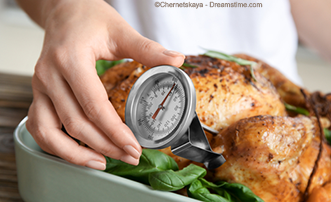September is National Food Safety Month. Anyone can become sick from a food-borne illness, which is defined as an illness caused by food contaminated with bacteria, viruses, parasites, or toxins.
POP QUIZ!
According to the Centers for Disease Control (CDC), how many Americans get sick or are hospitalized from food-borne illness each year?
A) 1 in 6 people
B) 48 million people
C) 128,000 people hospitalized
D) 3,000 people die
E) All of the above
If you answered “E) All of the above,” you are correct. Food-borne illnesses affect many people each year and to varying degrees. Those who are 65 and older, or those with a compromised immune system, may have a much more serious illness. It’s important to know how to keep food safe to be sure we haven’t caused a food-borne illness. Here are some things to keep in mind:
1. Clean
Be sure to wash your hands and clean surfaces often.
• Wash your hands with warm, soapy water for at least 20 seconds before and after handling food and after switching tasks such as using the bathroom or touching your face, hair, or clothing.
• Wash cutting boards, dishes, utensils, and counter tops with hot, soapy water after preparing each food item.
• Consider using paper towels to clean up kitchen surfaces. Cloth towels and sponges can often harbor bacteria.
• Remember to clean the lids of canned goods before opening.
2. Separate
Raw meats should never come in contact with other foods.
• Be sure to separate meat, poultry, seafood, and eggs from other foods in your refrigerator. Sometimes raw meats can have liquid in the packaging that can leak on to other foods that could be carrying bacteria or a virus that could cause food-borne illnesses.
• Don’t reuse marinades unless bringing to a boil first.
3. Cook
Cook to the right temperature.
• The only way to know if meat, poultry, seafood, and egg products are thoroughly cooked is to use a food thermometer. Be sure to check out the minimum internal temperatures for these items. If it hasn’t reached the minimum internal temperature, the heat may not have destroyed any harmful bacteria.
• Bring sauces, soups, and gravy to a boil when reheating.
4. Chill
Refrigerate foods promptly.
• Be sure your refrigerator is consistently below 40°F and the freezer is 0°F or below.
• Refrigerate meat, poultry, eggs, seafood, and other perishables within 2 hours of cooking.
• Never thaw food at room temperature. Defrost in the refrigerator, in cold water, or in the microwave.
• Divide large amounts of leftovers into smaller, shallow containers for quicker cooling in the refrigerator.
Know the Symptoms
After consuming the contaminated food, symptoms may occur within 1-3 days. However, it can also occur within 20 minutes or up to 6 weeks later. Symptoms include vomiting, diarrhea, and abdominal pain. Flu-like symptoms like fever, headache, and body aches can also occur.
Source: FDA.gov




